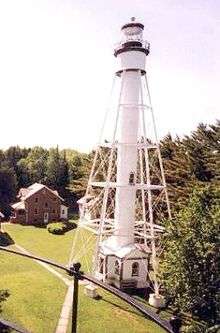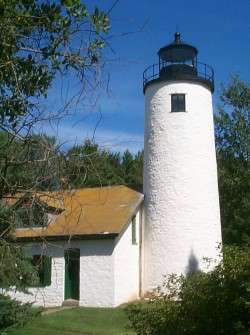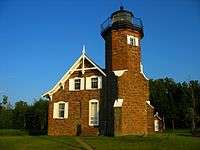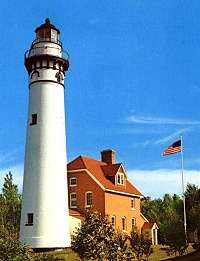Michigan Island Light
The Michigan Island Lighthouse is a lighthouse operated by the National Park Service and located on Michigan Island on western Lake Superior in the Apostle Islands National Lakeshore.
 The current tower | |
 | |

| |
| Location | Michigan Island, Wisconsin |
|---|---|
| Coordinates | 46°52′17.154″N 90°29′49.545″W[1] |
| Year first constructed | 1857 |
| Year first lit | 1869 |
| Automated | 1943 |
| Foundation | Concrete |
| Construction | Steel |
| Tower shape | White, Skeletal with a central column |
| Tower height | 118 feet (36 m) |
| Focal height | 170 feet (52 m) |
| Original lens | Third and half order Fresnel lens |
| Current lens | 12-inch (300 mm)Tideland Signal ML-300 Acrylic Optic |
| Range | 11 nautical miles (20 km; 13 mi)[1] |
| Characteristic | White, Flashing, 6 sec[1] |
| ARLHS number | USA-494 |
| USCG number | 7-15275 |
| Heritage | NRHP contributing property |
Michigan Island Light | |
| Area | 33.8 acres (13.7 ha) |
| Built | 1857 |
| Built by | U.S. Lighthouse Service |
| Part of | Apostle Islands Lighthouses (ID77000145[2]) |
| Added to NRHP | March 8, 1977 |
History
Two historical lighthouses have served as the Michigan Island light. The older was constructed in 1857, but not activated until 1869. It served until 1929, when it was replaced by a taller, 118-foot (36 m) skeletal tower, which is still operational.
The 3½-order Fresnel lens, coupled with a 24,000-candela electric light and the 170-foot (52 m) focal plane (aided by its placement on a cliff) aided by the tower's location atop the cliff, made the light range of visibility to a "remarkable 22 miles."[3] This was a relative rarity, being one of only a dozen used around the country, most of which were on the Great Lakes,[4] These lights were typically reserved for places that were an especially serious hazard to navigation. See, for example, Sturgeon Point Light. Other Great Lakes lights that had 3½-order Fresnel lenses were at (in alphabetical order): DeTour Reef, Eagle Bluff, Grays Reef, Huron Island, St. Helena Island, and Toledo Harbor.[4]
In 1972, the original Fresnel lens was replaced with a DCB-224 aero beacon[5] manufactured by the Carlisle & Finch Company. In turn, that was replaced by the 12-inch (300 mm)Tideland Signal ML-300 acrylic optic.[6] The restored Fresnel lens is on display at the visitor center of the Apostle Islands National Lakeshore in Bayfield.[3]
The structure shares its design with towers at Rawley Point Light on Lake Michigan and Whitefish Point Light at Lake Superior's eastern end. However, the Michigan Island tower has a small brick building located at the base of the center tube, apparently a workroom for the early lighthouse keepers.[7]
Status
Currently owned by the National Park Service and part of the Apostle Islands National Lakeshore, it is a contributing property of the Apostle Islands Lighthouses, added to the National Register of Historic Places in 1977.[2] It is also listed in the Library of Congress, Historic American Buildings Survey, WI-317 (A-C).
Transportation
Most of the Apostle Islands light stations can be reached on the Apostle Islands Cruise Service[8] water taxi or by private boat during the summer. During the Annual Apostle Island Lighthouse Celebration,[9] a ferry tour service is available for all the lighthouses. During the tourist season, volunteer park rangers are on many of the islands to greet visitors.[10]
- U.S. Coast Guard archive photo
 The original Michigan Island light
The original Michigan Island light- Original Michigan Island lighthouse lens, on display at the Apostle Islands National Lakeshore office in Bayfield
See also
- Wisconsin lighthouses
- Apostle Islands Lighthouses
References
- Light List, Volume VII, Great Lakes (PDF). Light List. United States Coast Guard.
- "National Register Information System". National Register of Historic Places. National Park Service. November 2, 2013.
- Terry Pepper, Seeing the Light, Michigan Island Light (New).
- Terry Pepper, Seeing the Light 3½-order Fresnel lens.
- Aero beacon, Terry Pepper, Seeing the Light.
- Tideland Signal 300 mm Acrylic Optic, Terry Pepper, Seeing the Light.
- Wobser, David, Michigan Island Lights, Great Laker Magazine, Boatnerd
- Apostle Islands Cruise Service.
- Apostle Island Lighthouse Celebration.
- Wobser, David. La Pointe Light, Boatnerd Originally in Great Laker Magazine
Further reading
- Havighurst, Walter (1943) The Long Ships Passing: The Story of the Great Lakes, Macmillan Publishers.
- Michigan Island: The Mistake that Became a Treasure. Lighthouse Digest (Mar 1999), pp. 21–24.
- Oleszewski, Wes (1998). Great Lakes Lighthouses, American and Canadian: A Comprehensive Directory/Guide to Great Lakes Lighthouses. Gwinn, Michigan: Avery Color Studios, Inc. ISBN 0-932212-98-0.
- Pepper, Terry. "Seeing the Light: Lighthouses on the western Great Lakes".
- Wobser, David, Michigan Island Lights, Great Laker Magazine, Boatnerd
- Wright, Larry and Wright, Patricia, Great Lakes Lighthouses Encyclopedia Hardback (Erin: Boston Mills Press, 2006) ISBN 1-55046-399-3.
External links
| Wikimedia Commons has media related to Michigan Island Light. |
- Aerial photos of Michigan Island Light, Marina.com.
- Lighthouse tour preview: September, 2005 VIP photo.
- Old tower Lighthouse friends article.
- New tower Lighthouse friends article.
- Michigan Island Light Station.
- National Park Service, Inventory of Historic Light Stations - Wisconsin, Michigan Island Lights.
- Library of Congress Historic American Buildings Survey Survey number HABS WI-317
- Terry Pepper, Seeing the Light, Michigan Island Light (New).
- Terry Pepper, Seeing the Light, Michigan Island Light (Old).
- Rowlett, Russ. "Lighthouses of the United States: Northern Wisconsin". The Lighthouse Directory. University of North Carolina at Chapel Hill.
- Light List, Volume VII, Great Lakes (PDF). Light List. United States Coast Guard.
- "Historic Light Station Information and Photography: Wisconsin". United States Coast Guard Historian's Office. Archived from the original on 2017-05-01.

